










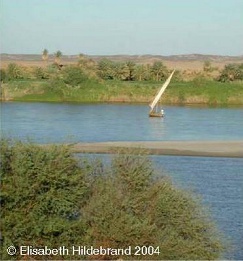
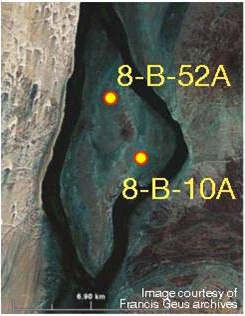
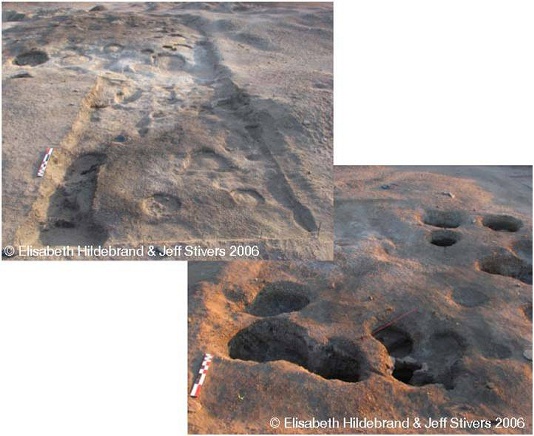
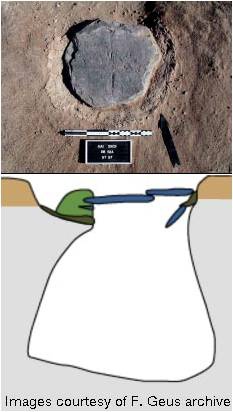
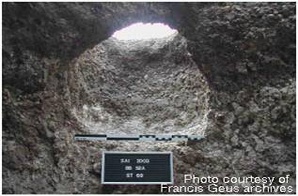

Research questions
Southwest Asian crops (wheat, barley and some pulses) entered Egypt 6000 years ago (bp). They gradually spread south up the Nile, but arid conditions limited farming to naturally irrigated floodplains. These exotic crops reached northern Sudan around 4000 years ago, before any indigenous plants were domesticated locally. But how exactly did early farming begin? Was it:
Southwest Asian crops (wheat, barley and some pulses) entered Egypt 6000 years ago (bp). They gradually spread south up the Nile, but arid conditions limited farming to naturally irrigated floodplains. These exotic crops reached northern Sudan around 4000 years ago, before any indigenous plants were domesticated locally. But how exactly did early farming begin? Was it:
- Organized by local elites to produce surpluses?
- Catalyzed by expeditions sent by early Dynastic rulers?
- An example of gradual, down-the-line adoption of agricultural technology?
- The result of organized long-distance trade with established farming societies farther north?
- Catalyzed by expeditions sent by early Dynastic rulers?
- An example of gradual, down-the-line adoption of agricultural technology?
- The result of organized long-distance trade with established farming societies farther north?
Context
Sai is one of the largest islands on the Nile in northern Sudan.
It has a long sequence of human use since Pleistocene times.
Before food production, its moist margins would have
supported many useful wild plants and animals. Higher rainfall
would have supported vegetation away from the Nile
9000-6000 years ago, but progressive desiccation occurred from 5000 bp on. Today, the river and its floodplains provide a linear oasis within a harsh desert environment.
Sai is just south of the Batn-el-Hajar (“Belly of Stones”), a vast series of rugged outcrops that impede travel along then Nile. Four thousand years ago, Sai was outside of the area of immediate early Dynastic influence. Pottery found on Sai Island suggests that people living there at this time were part of the Pre-Kerma cultural sphere, which extended up the Nile past the 3rd cataract.
Sai is one of the largest islands on the Nile in northern Sudan.
It has a long sequence of human use since Pleistocene times.
Before food production, its moist margins would have
supported many useful wild plants and animals. Higher rainfall
would have supported vegetation away from the Nile
9000-6000 years ago, but progressive desiccation occurred from 5000 bp on. Today, the river and its floodplains provide a linear oasis within a harsh desert environment.
Sai is just south of the Batn-el-Hajar (“Belly of Stones”), a vast series of rugged outcrops that impede travel along then Nile. Four thousand years ago, Sai was outside of the area of immediate early Dynastic influence. Pottery found on Sai Island suggests that people living there at this time were part of the Pre-Kerma cultural sphere, which extended up the Nile past the 3rd cataract.
Two sites on Sai Island give indications of life during Pre-Kerma times (~4800-3800 bp):
8-B-10A is a habitation site near the southeast edge of the island that was periodically inundated by Nile floods.
8-B-52A is a special-use site in the north-central part of the island. It has >100 pits, many of which appear to have been used for storage. They were sealed with large slabs of local schist held by daub tempered with Nile gravels and plant waste. Excavations at the site began under the direction of Francis Geus, who obtained the first dates on domestic barley found in one of the pits (~4100 bp).
8-B-10A is a habitation site near the southeast edge of the island that was periodically inundated by Nile floods.
8-B-52A is a special-use site in the north-central part of the island. It has >100 pits, many of which appear to have been used for storage. They were sealed with large slabs of local schist held by daub tempered with Nile gravels and plant waste. Excavations at the site began under the direction of Francis Geus, who obtained the first dates on domestic barley found in one of the pits (~4100 bp).
Top: Pit opening at 8-B-52A, sealed by a schist slab embedded in daub.
Bottom: Profile of bell-shaped pit. 8-B-52A also has cylindrical and hemispherical pits of various sizes.
Bottom: Profile of bell-shaped pit. 8-B-52A also has cylindrical and hemispherical pits of various sizes.
Recent results
I was first invited to Sai as an archaeobotanical specialist.
After the death of Francis Geus in 2005, I continued
work at 8-B-52A and 8-B-10A with funds from the US National Science Foundation. Research by my team has clarified several aspects of early food production and storage on the island:
1. Although people followed a fairly consistent recipe for making daub, different plants were incorporated into different batches of daub. These results, plus new dates on plant material embedded in the daub from different pits, indicate that 8-B-52A was constructed and renovated in multiple episodes over several centuries, not in a short period.
I was first invited to Sai as an archaeobotanical specialist.
After the death of Francis Geus in 2005, I continued
work at 8-B-52A and 8-B-10A with funds from the US National Science Foundation. Research by my team has clarified several aspects of early food production and storage on the island:
1. Although people followed a fairly consistent recipe for making daub, different plants were incorporated into different batches of daub. These results, plus new dates on plant material embedded in the daub from different pits, indicate that 8-B-52A was constructed and renovated in multiple episodes over several centuries, not in a short period.
2. The distribution, variable size, and variable shape of pits at 8-B-52A are not suggestive of a facility
organized under central direction for collection and appropriation of a surplus. Rather, the
configuration of the site is consistent with households or extended families constructing pits for
private use.
3. The preponderance of local Pre-Kerma pottery at both of these sites, rather than Egyptian Dynastic and/or A-Group ceramics, suggests that long-distance trade was occasional rather than routine.
4. The absence of habitation features at 8-B-52A, and the distribution of Pre-Kerma artifacts elsewhere on Sai, suggest that the gently sloping plains on the SE portion of the island were the primary focus of living and subsistence activities. 8-B-52A’s location was probably chosen due to a local outcrop of moderately friable mudstone, into which pits could be dug.
3. The preponderance of local Pre-Kerma pottery at both of these sites, rather than Egyptian Dynastic and/or A-Group ceramics, suggests that long-distance trade was occasional rather than routine.
4. The absence of habitation features at 8-B-52A, and the distribution of Pre-Kerma artifacts elsewhere on Sai, suggest that the gently sloping plains on the SE portion of the island were the primary focus of living and subsistence activities. 8-B-52A’s location was probably chosen due to a local outcrop of moderately friable mudstone, into which pits could be dug.
Emerging data are not consistent with the trade, elite,
or expedition hypotheses outlined above. So far,
however, they are fairly consistent with the
down-the-line adoption hypothesis, and suggest that
people of Sai Island took on forms of farming from near
neighbors to the north, integrated them into livelihoods
previously based on hunting, gathering, and herding, and
eventually made innovations in storage leading to the
creation of new kinds of special sites.
New perspectives on the spread of farming at Sai Island
Publications on Sai research
Garcea, Elena and Elisabeth Hildebrand. 2009. Interregional interactions along the Nile during the Middle Holocene: Ceramics from Sai Island. Journal of Anthropological Archaeology 28:304-322.
Hildebrand, Elisabeth. 2007. The significance of Sai Island for early plant food production in Sudan. CRIPEL (Cahiers de Recherche de l’Institute de Papyrologie et Egyptologie à Lille) 26.
Garcea, Elena and Elisabeth Hildebrand. 2009. Interregional interactions along the Nile during the Middle Holocene: Ceramics from Sai Island. Journal of Anthropological Archaeology 28:304-322.
Hildebrand, Elisabeth. 2007. The significance of Sai Island for early plant food production in Sudan. CRIPEL (Cahiers de Recherche de l’Institute de Papyrologie et Egyptologie à Lille) 26.
Standing inside large pit (>1.5 m deep) at
8-B-52A, with view of friable mudstone bedrock
into which the pit was dug.
Sunrise view of the Nile channel and Jebel Abri, east of Sai Island.
Early farming on Sai Island, northern Sudan
Nile channel east of Sai Island.
Map of Sai Island.
Photographs of storage pits at
8-B-52A.






